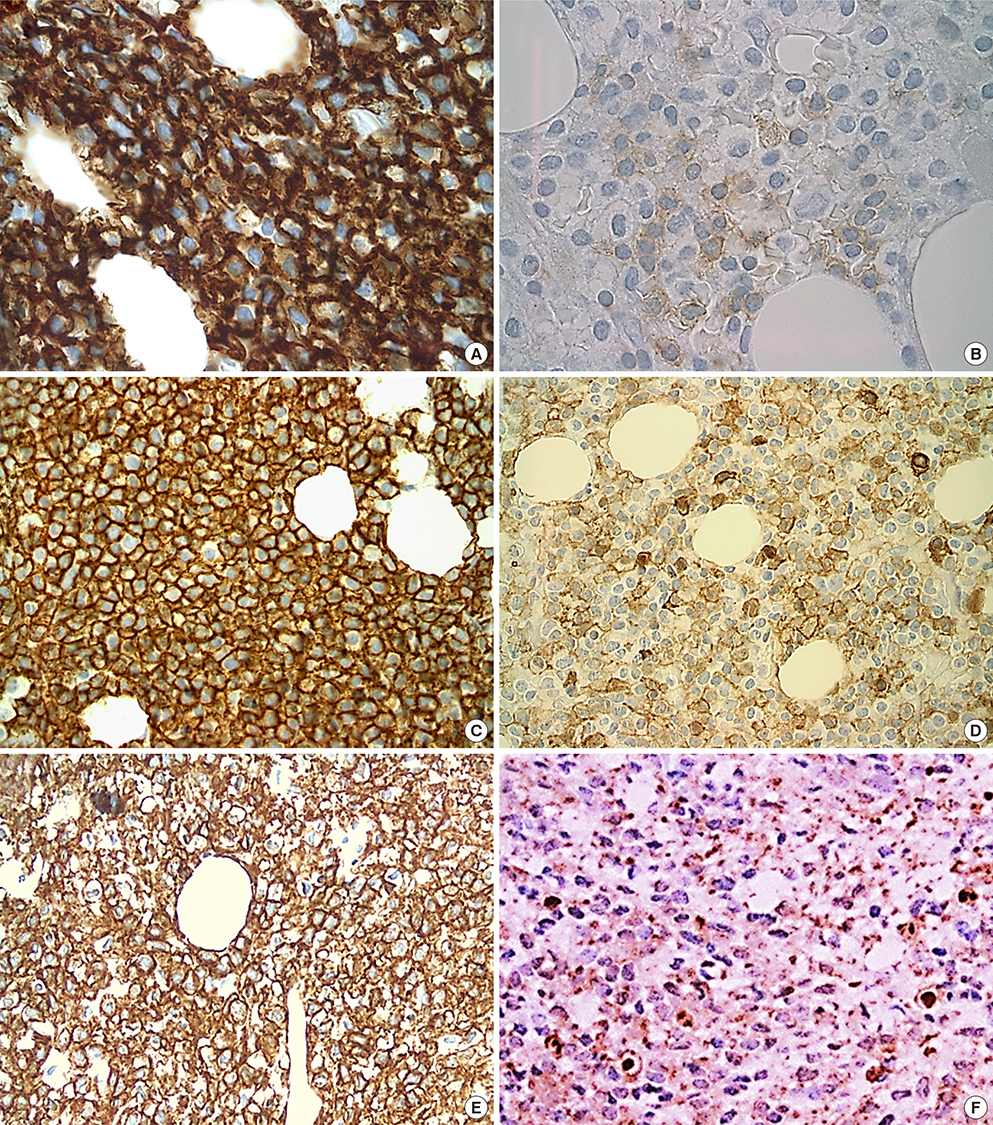Lab Med Online.
2019 Oct;9(4):236-241. 10.3343/lmo.2019.9.4.236.
Efficacy of Annexin A1 Immunostaining in Bone Marrow for the Diagnosis of Hairy Cell Leukemia
- Affiliations
-
- 1Department of Laboratory Medicine and Genetics, Samsung Changwon Hospital, Sungkyunkwan University School of Medicine, Changwon, Korea.
- 2Department of Laboratory Medicine and Genetics, Samsung Medical Center, Sungkyunkwan University School of Medicine, Seoul, Korea. sunnyhk@skku.edu
- 3Department of Laboratory Medicine, Gyeongsang National University Hospital, Jinju, Korea.
- 4Department of Laboratory Medicine, Seoul Metropolitan Dongbu Hospital, Seoul, Korea.
- 5Department of Medicine, Samsung Medical Center, Sungkyunkwan University School of Medicine, Seoul, Korea.
- KMID: 2458684
- DOI: http://doi.org/10.3343/lmo.2019.9.4.236
Abstract
- Splenic B-cell lymphomas (SBCLs) show characteristically pronounced splenomegaly without significant lymphadenopathy. Distinguishing hairy cell leukemia (HCL) from other SBCLs (splenic marginal zone lymphoma [SMZL], variant HCL [v-HCL], and splenic diffuse red pulp small B-cell lymphoma [SDRPL]) is essential to determine suitable treatments and prognoses. With advances in diagnostic modalities and therapies, splenectomy is not commonly performed, and thus diagnosis of HCL must be based on the results obtained using blood and bone marrow samples. Annexin A1 is known as the most specific marker for HCL. There has yet been no report of the assessment of annexin A1 immunostaining from Korea. In this study we analyzed samples from 13 Korean patients with SBCLs (three HCL, three v-HCL, six SMZL, and one SDRPL) from May 2001 to December 2016. Immunohistochemical analyses for annexin A1 and CD20 were performed using bone marrow sections; molecular analyses for detection of the BRAF V600E mutation were also performed. All HCL patients showed positive results for annexin A1 immunostaining and the presence of the BRAF V600E mutation, and negative results for other SBCLs. Our results confirmed the high specificity of annexin A1 and the BRAF V600E mutation as HCL markers. Molecular analysis requires expensive equipment and substantial manpower. Annexin A1 is a better alternative as an HCL marker than the BRAF V600E mutation in terms of cost-effectiveness.
Keyword
MeSH Terms
Figure
Reference
-
1. Swerdlow SH, Campo E, editors. WHO classification of tumours of haematopoietic and lymphoid tissues. Revised 4th ed. Lyon, France: World Health Organization;2017.2. Grever MR. How I treat hairy cell leukemia. Blood. 2010; 115:21–28.
Article3. Dong HY, Weisberger J, Liu Z, Tugulea S. Immunophenotypic analysis of CD103+ B-lymphoproliferative disorders: hairy cell leukemia and its mimics. Am J Clin Pathol. 2009; 131:586–595.
Article4. Venkataraman G, Aguhar C, Kreitman RJ, Yuan CM, Stetler-Stevenson M. Characteristic CD103 and CD123 expression pattern defines hairy cell leukemia: usefulness of CD123 and CD103 in the diagnosis of mature B-cell lymphoproliferative disorders. Am J Clin Pathol. 2011; 136:625–630.
Article5. Matutes E, Wotherspoon A, Catovsky D. The variant form of hairy-cell leukaemia. Best Pract Res Clin Haematol. 2003; 16:41–56.
Article6. Ponzoni M, Kanellis G, Pouliou E, Baliakas P, Scarfò L, Ferreri AJ, et al. Bone marrow histopathology in the diagnostic evaluation of splenic marginal-zone and splenic diffuse red pulp small B-cell lymphoma: a reliable substitute for spleen histopathology? Am J Surg Pathol. 2012; 36:1609–1618.
Article7. Kanellis G, Mollejo M, Montes-Moreno S, Rodriguez-Pinilla SM, Cigudosa JC, Algara P, et al. Splenic diffuse red pulp small B-cell lymphoma: revision of a series of cases reveals characteristic clinico-pathological features. Haematologica. 2010; 95:1122–1129.
Article8. Traverse-Glehen A, Baseggio L, Bauchu EC, Morel D, Gazzo S, Ffrench M, et al. Splenic red pulp lymphoma with numerous basophilic villous lymphocytes: a distinct clinicopathologic and molecular entity? Blood. 2008; 111:2253–2260.
Article9. Basso K, Liso A, Tiacci E, Benedetti R, Pulsoni A, Foa R, et al. Gene expression profiling of hairy cell leukemia reveals a phenotype related to memory B cells with altered expression of chemokine and adhesion receptors. J Exp Med. 2004; 199:59–68.
Article10. Zhu DW, Liu Y, Yang X, Yang CZ, Ma J, Qiao JK, et al. Low Annexin A1 expression predicts benefit from induction chemotherapy in oral cancer patients with moderate or poor pathologic differentiation grade. BMC Cancer. 2013; 13:301.
Article11. Falini B, Tiacci E, Liso A, Basso K, Sabattini E, Pacini R, et al. Simple diagnostic assay for hairy cell leukaemia by immunocytochemical detection of annexin A1 (ANXA1). Lancet. 2004; 363:1869–1870.
Article12. Jang MJ, Rhyu KH, Chong SY, Oh D, Kang MS. A case of hairy cell leukemia, variant. Korean J Hematol. 2004; 39:167–171.13. Kang SB, Park WS, Lee KM, Lee DS, Kim KW, Kim HJ, et al. A case of hairy cell leukemia. Korean J Hematol. 2000; 35:92–96.14. Shin SY, Lee ST, Kim HJ, Ki CS, Jung CW, Kim JW, et al. BRAF V600E and MAP2K1 mutations in hairy cell leukemia and splenic marginal zone lymphoma cases. Ann Lab Med. 2015; 35:257–259.
Article15. Lee ST, Kim JY, Kown MJ, Kim SW, Chung JH, Ahn MJ, et al. Mutant enrichment with 3′-modified oligonucleotides a practical PCR method for detecting trace mutant DNAs. J Mol Diagn. 2011; 13:657–668.16. Shao H, Calvo KR, Grönborg M, Tembhare PR, Kreitman RJ, Stetler-Stevenson M, et al. Distinguishing hairy cell leukemia variant from hairy cell leukemia: development and validation of diagnostic criteria. Leuk Res. 2013; 37:401–409.
Article17. Xi L, Arons E, Navarro W, Calvo KR, Stetler-Stevenson M, Raffeld M, et al. Both variant and IGHV4-34-expressing hairy cell leukemia lack the BRAF V600E mutation. Blood. 2012; 119:3330–3332.
Article18. Mori A, Deola S, Xumerle L, Mijatovic V, Malerba G, Monsurrò V. Next generation sequencing: new tools in immunology and hematology. Blood Res. 2013; 48:242–249.
Article


